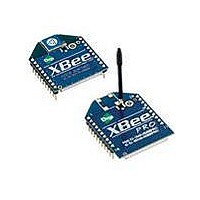XBP24-DMUIT-250 Digi International, XBP24-DMUIT-250 Datasheet - Page 28

XBP24-DMUIT-250
Manufacturer Part Number
XBP24-DMUIT-250
Description
XBEE-PRO MESH 2.4 EXTENDED
Manufacturer
Digi International
Series
XBEE-PRO™r
Specifications of XBP24-DMUIT-250
Frequency
2.4GHz
Data Rate - Maximum
250kbps
Modulation Or Protocol
DSSS
Power - Output
18dBm
Sensitivity
-100dBm
Voltage - Supply
2.8 V ~ 3.4 V
Current - Receiving
55mA
Current - Transmitting
250mA
Data Interface
PCB, Through Hole
Antenna Connector
U.FL
Operating Temperature
-40°C ~ 85°C
Lead Free Status / RoHS Status
Lead free / RoHS Compliant
Package / Case
-
Applications
-
Memory Size
-
Lead Free Status / Rohs Status
Lead free / RoHS Compliant
Other names
Q4197953C
XBee/XBee‐PRO DigiMesh 2.4 RF Modules
Configuration
If a sleep compatible node has missed three or more sync messages (presumably because the sleep coordinator has
been disabled) it may become a sleep coordinator. Depending on the platform and other configured options such a
node will eventually nominate itself after a number of cycles without a sync. A nominated node will begin acting as
the new network sleep coordinator.
It is possible for multiple nodes to nominate themselves as the sleep coordinator. If this occurs then an election will
take place to establish seniority among the multiple sleep coordinators. A node will cease being the sleep coordina-
tor if it receives a sync message from a senior node.
Seniority is determined on the basis of four factors (in order of priority):
Commissioning Button
The commissioning button can be used to select a module to act as the sleep coordinator. If the commissioning but-
ton functionality has been enabled a node can be immediately nominated as a sleep coordinator by pressing the
commissioning button twice or by issuing the CB2 command. A node nominated in this manner is still subject to the
election process described previously. Nodes which are configured as a non-sleep coordinator will ignore commis-
sioning button nomination requests.
Changing Sleep Parameters
Any sleep compatible node in the network which does not have the non-sleep coordinator sleep option set can be
used to make changes to the network's sleep and wake times. If a node's SP and/or ST are changed to values dif-
ferent from those that the network is using then that node will become the sleep coordinator. That node will begin
sending sync messages with the new sleep parameters at the beginning of the next wake cycle.
Note #1: For normal operations a module will use the sleep and wake parameters it gets from the sleep sync message,
not the ones specified in its SP and ST parameters. The SP and ST parameters are not updated with the values of the sync
message. It is not necessary for all nodes in the network to have the same SP and ST parameters. The current network
sleep and wake time that node is currently using can be queried with the OS and OW commands.
Note #2: It should be noted that changing network parameters can cause a node to become a sleep coordinator and
change the sleep settings of the network. The following commands may cause this to occur: NH, NN, NQ, and MR. In
most applications these network parameters should only be configured during deployment.
To compensate for variations in the timekeeping hardware of the various modules in a sleeping router network sleep
guard times are allocated at the beginning and end of the wake time. The size of these sleep guard times vary based
on the sleep and wake times selected and the number of cycles that have elapsed since the last sync message was
received. These sleep guard times guarantee that a destination radio will be awake when a transmission is initiated.
As more and more consecutive sync messages are missed the sleep guard times increase in duration and decrease
the available transmission time.
In a similar manner to the sleep guard times the auto-early wakeup option decreases the sleep period based on the
number of sync messages missed. This function guarantees that the module will be awake when the sync message
is sent. This option comes at the expense of battery life. This option can be disabled using the sleep options (SO)
command.
Choosing proper sleep parameters is important to create a sleep-enabled network which will be robust and have the
desired battery life. The following steps can be taken to select sleep parameters which will be good for most appli-
cations:
Choosing proper sleep parameters is important to create a sleep-enabled network which will be robust and have the
desired battery life. The following steps can be taken to select sleep parameters which will be good for most appli-
cations:
Sleep Guard Times
Auto-Early Wakeup Sleep Option
Selecting Sleep Parameters
1.
2.
3.
4.
Newer sleep parameters: a node using newer sleep parameters (SP/ST) is considered senior to a node
using older sleep parameters. (See the "Changing Sleep Parameters" section below).
Preferred Sleep Coordinator: a node acting as a preferred sleep coordinator is senior to other nodes.
Sleep Support Node: sleep support nodes are senior to cyclic sleep nodes.
Serial Number: in the event that the above factors do not resolve seniority then the node with the higher
serial number is considered senior.
© 2010 Digi International, Inc.
28














